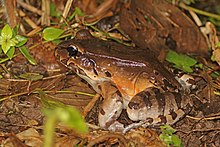
Centrolene prosoblepon is a species of frog in the family Centrolenidae, commonly known as the emerald glass frog or Nicaragua giant glass frog. This species can be found in Ecuador, Colombia, Panama, Costa Rica, Nicaragua, and Honduras. Its natural habitats are lowland tropical forests and montane cloud forests. It is a nocturnal species occurring in low vegetation in mature forests only. It is not considered threatened overall by the IUCN although deforestation and pollution are potential threats, as is chytridiomycosis.

Colostethus pratti is a species of frog in the family Dendrobatidae. It is found in the northwestern Colombia and Panama, possibly also in southeastern Costa Rica. It is sometimes known as the Pratt's rocket frog. Colostethus pratti is named after Antwerp Edgar Pratt, an explorer who collected the type series.
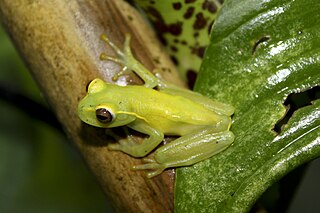
The La Loma tree frog is a species of frog in the family Hylidae found in Costa Rica, Panama, and expected but not confirmed in Colombia. Its natural habitats are tropical moist lowland and montane forests, with breeding taking place in streams. It is threatened by habitat loss and chytridiomycosis.

Rosenberg's treefrog, also known as Rosenberg's gladiator frog or Rosenberg's gladiator treefrog, is a species of frog in the family of tree frogs (Hylidae) and genus of gladiator frogs (Boana) found in Costa Rica, Panama, Colombia, Trinidad and Tobago and north-western Ecuador. Its scientific name is a testimony to Mr. W. F. H. Rosenberg who collected the type series, and its common name refers to the aggressiveness of males of the species.

The Panama cross-banded tree frog or pug-nosed tree frog is a species of frog in the family Hylidae found in the humid Pacific lowlands of southwestern Costa Rica to eastern Panama and in the Caribbean lowlands of Panama and northern Colombia. Males of the species utilize synchronous calling to hide their position from predators. Females create basins during amplexus and deposit fertilized eggs onto the surface of the water.
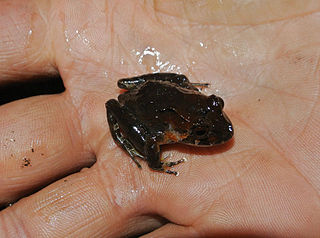
Tachiramantis tayrona is a species of frog in the family Strabomantidae. It is endemic to the north-western Sierra Nevada de Santa Marta, Colombia. The specific name tayrona refers to the pre-Columbian Tairona culture. Lynch and Ruíz-Carranza suggest that this species might have been a model for the gold frogs unearthed from archaeological sites in the area.

Leptodactylus albilabris is a species of frog in the family Leptodactylidae.
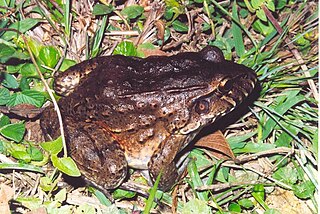
Leptodactylus labyrinthicus is a species of frog in the family Leptodactylidae. Its common names are labyrinth frog, pepper frog, South American pepper frog, and pepper foam frog. This frog is found in central and southeastern Brazil, northeast Argentina, and eastern Paraguay. Earlier reports from Bolivia refer to Leptodactylus vastus, or possibly an unnamed species.

Leptodactylus mystacinus is a species of frog in the family Leptodactylidae. It is found in eastern Bolivia and eastwards to Brazil, Paraguay, and Uruguay and southwards to central Argentina. It is also known as the mustached frog.
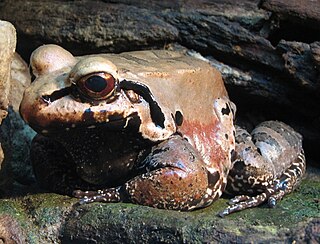
The smoky jungle frog is a species of frog in the family Leptodactylidae. It is found in Bolivia, Brazil, Colombia, Ecuador, Costa Rica, Panama, French Guiana, Perú and Venezuela. Its natural habitats are tropical and subtropical moist broadleaf forests, subtropical or tropical swamps, subtropical or tropical moist montane forest, rivers, freshwater marshes, intermittent freshwater marshes, and aquaculture ponds.
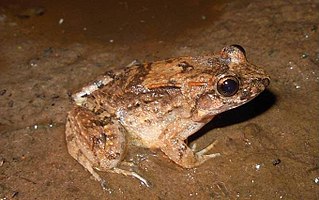
Leptodactylus petersii is a species of frog in the family Leptodactylidae. It is found widely in the Guianas and the Amazon Basin. It has been confused with Leptodactylus podicipinus and Leptodactylus wagneri, complicating the interpretation of older records and accounts.

Leptodactylus podicipinus, sometimes known as the pointedbelly frog, is a species of frog in the family Leptodactylidae. It is found in northern Argentina, Paraguay, Uruguay, Bolivia, and Brazil.

Leptodactylus syphax is a species of frog in the family Leptodactylidae. It is found in extreme eastern Bolivia, central to northeastern Brazil, and Paraguay. Common names basin white-lipped frog and whistling foam frog have been coined for it.

Lithodytes is a genus of frogs in the family of Leptodactylidae. It is monotypic, being represented by the single species, Lithodytes lineatus, also commonly known as the gold-striped frog or painted antnest frog. It is found in tropical South America where it lives in humid forests among the leaf litter. These frogs build foam nests at the edge of temporary pools, and the tadpoles develop within these. The frogs also associate with certain leafcutter ants and breed inside their nests without being attacked by the ants.

Leptodactylus discodactylus is a species of frog in the family Leptodactylidae. It is found in the Amazonian Bolivia, Brazil, Peru, Ecuador, and Colombia.
Zhangixalus omeimontis is a species of frog in the family Rhacophoridae endemic to China. Its common name is Omei whipping frog or Omei treefrog, in reference to its type locality, Mount Emei (Chinese: 峨嵋山; pinyin: Éméi Shān; Wade–Giles: O2-mei2 Shan1) in Sichuan. It is found in southern and central China in Yunnan, Sichuan, Guangxi, Guizhou, Hunan, and Hubei provinces. It has been observed between 200 and 700 meters above sea level. It is a relatively common frog that inhabits forests, and sometimes farmland. It breeds in still water (pools and ponds). Agriculture and logging are threats to this species.

Leptodactylus fallax, commonly known as the mountain chicken or giant ditch frog, is a critically endangered species of frog that is native to the Caribbean islands of Dominica and Montserrat. The population declined by at least 80% from 1995 to 2004, with further significant declines later. A tiny wild population remains on Dominica where there are efforts to preserve it, but few or none survive in the wild on Montserrat and its survival now relies on a captive breeding project involving several zoos. The initial decline was linked to hunting for human consumption, along with habitat loss and natural disasters, but the most serious threat now appears to be the fungal disease chytridiomycosis, which was the primary cause of the most recent rapid decline. On Montserrat it is known as the mountain chicken, while on Dominica it is known as the crapaud, which is simply the French word for "toad".

Ecnomiohyla rabborum, commonly known as Rabbs' fringe-limbed treefrog, is a possibly extinct species of frog in the family Hylidae. They were relatively large frogs that inhabited the forest canopies of central Panama. Like other members of the genus Ecnomiohyla, they were capable of gliding by spreading their enormous and fully webbed hands and feet during descent. The males of the species were highly territorial and would guard water-filled tree holes used for breeding. They were also the ones responsible for guarding and caring for the young, including providing food. They were the only known species of frog where the tadpoles derived nutrition by feeding on the skin cells of their fathers.

Centrolene savagei is a species of frog in the family Centrolenidae that is endemic to the Andes of western Colombia, specifically the Cordillera Occidental and Cordillera Central. Its common name is Savage's Cochran frog.

Rhacophorus kio is a species of flying frog in the family Rhacophoridae and is found in the rainforests of southeast Asia, in countries such as China, Laos, Thailand, and Vietnam. Its ability to glide and its adhesive toe pads make it well adapted to its habitat of the rainforest. Prior to a 2006 study by Annemarie Ohler and Magali Delorme, R. kio and R. reinwardtii were thought to be the same species. The common name black-webbed treefrog can refer to either species. Compared to other frog species in the area, R. kio not only creates a foam nest that holds their eggs, but also creates a structure with leaves that will wrap around the eggs. While the conservation status of the species is currently classified as of least concern by the IUCN Red List, R. kio faces habitat loss from deforestation to make space for agriculture and other human influences.
